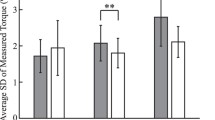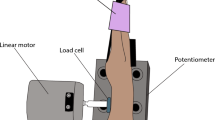Abstract
When studying muscle stretch reflexes with tonic stimuli or making a clinical assessment of muscle tone, it is imperative that the subject does not track the stretch stimulus either consciously or unconsciously. Such tracking contaminates reflex responses with voluntary ones and so invalidates any conclusions reached. Ideally, the stimuli used should be beyond the speed of a person's tracking ability. Both experiments on tonic stretch reflexes and clinical assessment of muscle tone of necessity involve the application of perturbations to the same limb from which a response is to be measured. These perturbations produce different peripheral feedback from the limb, including particularly cutaneous signals but also different Golgi tendon and muscle spindle afference than would occur for similar movements made voluntarily. This combination of peripheral signals resulting from perturbation of a limb is referred to here as perturbational feedback. There is evidence in the literature that subjects can generate voluntary responses to same-limb perturbations within latencies normally accepted for reflexes. Such fast responses might enable faster targets to be tracked voluntarily. In this study the tracking frequency response for the forearm was investigated using sinusoidal and irregular target signals. Perturbations were applied to a manipulandum and the subjects were required to voluntarily track these perturbations under two conditions: (1) where their arm was secured in the manipulandum and therefore they had perturbational feedback of tracking errors and (2) where their tracking arm was not in contact with the manipulandum and they had only visual or kinesthetic feedback of tracking errors. For sinusoidal target inputs, perturbational feedback allowed superior tracking performance. Many subjects could produce good tracking responses at 5 Hz and some as high as 7 Hz. This is a considerably higher frequency than was found when perturbational feedback was not present and greater than has been reported in the literature for all other types of tracking (typically about 2 Hz). In contrast, when irregular signals having power up to 4 Hz were used, perturbational feedback conferred only a marginal advantage on tracking performance. The enhancement of sinusoidal tracking performance by feedback may be due to the fact that cyclic movements can be internally generated by the subject and minimal reference to external cues provided by perturbational feedback can be used to synchronise such self-generated movements with a target. In contrast, this proposed mechanism cannot be used for tracking of irregular targets. Since perturbational feedback did not improve the maximum tracking frequency for irregular targets, there was no evidence for the operation of a shorter latency, same-limb displacement response.
Similar content being viewed by others
References
Bendat JS, Piersol AG (1971) Random data: analysis and measurement procedures. Wiley-Interscience, New York
Ellson DG, Gray F (1948) Frequency response of human operator following a sine wave input. USAF AMC Memo Rep. No. MCREXD-694-2N
Evarts E, Granit R (1976) Relations of reflexes and intended movements. Prog Brain Res 44:1–14
Evarts EV, Tanji J (1976) Reflexes and intended responses in motor cortex pyramidal tract neurons of monkey. J Neurophysiol 39:1069–1080
Evarts EV, Vaughn WJ (1978) Intended arm movements in response to externally produced arm displacements in man. In: Desmedt JE (ed) Cerebral motor control in man: long loop mechanisms. (Progress in Clinical Neurophysiology, vol 4) Karger, Basel, pp 178–192
Leist A, Freund HJ, Cohen B (1987) Comparative characteristics of predictive eye-hand tracking. Hum Neurobiol 6:19–26
Neilson PD (1972a) Speed of response or bandwidth of voluntary system controlling elbow position in intact man. Med Biol Eng 10:450–459
Neilson PD (1972b) Frequency-response characteristics of the tonic stretch reflexes of biceps brachii muscle in intact man. Med Biol Eng 10:460–472
Neilson PD, Neilson MD (1980) Influence of control-display compatibility on tracking behaviour. Q J Exp Psychol 32:125–135
Neilson PD, O'Dwyer NJ, Neilson MD (1988) Stochastic prediction in pursuit tracking: an experimental test of adaptive model theory. Biol Cybern 58:113–122
Neilson PD, Neilson MD, O'Dwyer NJ (1993) What limits high speed tracking performance? Hum Mov Sci 12:85–109
Noble M, Fitts PM, Warren CE (1955) The frequency response of skilled subjects in a pursuit tracking task. J Exp Psychol 49:249–256
Pew RW, Duffendack JC, Fensch LK (1967) Sine-wave tracking revisited. IEEE Trans Hum Factors Electron 8:130–134
Poulton EC (1974) Tracking skill and manual control. Academic, New York
Rack PMH (1973) The stretch reflex response to movement of human elbow joint. In: Stein RB, Pearson KG, Smith RB, Redford JB (eds) Control of posture and locomotion. Plenum, New York, pp 245–255
Stark LW (1968) Neurological control systems: studies in bioengineering. Plenum, New York
Stark LW, Iida M, Willis PA (1961) Dynamic characteristics of the motor coordination system in man. Biophys J 1:279–300
Zahalak GI, Heyman SJ (1979) A quantitative evaluation of the frequency-response characteristics of active human muscle in vivo. Trans ASME 101:28–37
Author information
Authors and Affiliations
Rights and permissions
About this article
Cite this article
Cathers, I., O'Dwyer, N. & Neilson, P. Tracking performance with sinusoidal and irregular targets under different conditions of peripheral feedback. Exp Brain Res 111, 437–446 (1996). https://doi.org/10.1007/BF00228733
Received:
Accepted:
Issue Date:
DOI: https://doi.org/10.1007/BF00228733




